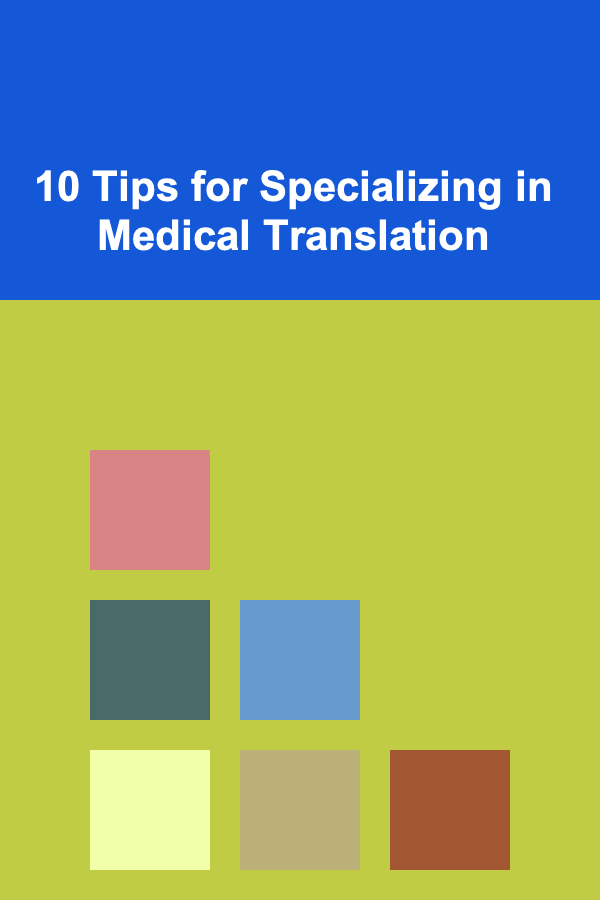
10 Tips for Specializing in Medical Translation
ebook include PDF & Audio bundle (Micro Guide)
$12.99$6.99
Limited Time Offer! Order within the next:

Medical translation is a highly specialized field within the broader realm of translation, and it demands a unique set of skills and knowledge. Translators working in this field are not only required to have excellent language proficiency but also a deep understanding of medical terminology, clinical practices, and scientific research. The goal is to ensure accurate, clear, and culturally appropriate communication in the context of healthcare, medical research, and pharmaceuticals. In this article, we will explore 10 essential tips for those looking to specialize in medical translation.
Gain a Solid Foundation in Medical Terminology
The foundation of medical translation lies in a comprehensive understanding of medical terminology. Whether you are translating medical documents, research papers, patient information leaflets, or clinical trial reports, being familiar with both general and specific medical terms is crucial.
Key Areas to Focus On:
- Anatomy and Physiology: Learn the terms related to human body systems, organs, and their functions.
- Pharmacology: Understand drug names, their chemical compositions, uses, side effects, and dosages.
- Medical Procedures: Be familiar with common procedures, surgical interventions, and diagnostic tests.
- Diseases and Conditions: Learn how to translate terms related to diseases, syndromes, and medical conditions.
- Medical Equipment: Understand the names and uses of medical instruments and technologies.
Tip:
Use specialized medical dictionaries and online resources, such as the US National Library of Medicine's Medical Subject Headings (MeSH), to deepen your understanding. Also, consider taking courses or certification programs in medical terminology to further solidify your knowledge.
Understand Different Medical Documents and Their Purposes
Medical translation covers a wide variety of document types, and each requires a specific approach. The style, tone, and accuracy depend heavily on the document's purpose and target audience.
Common Types of Medical Documents:
- Patient Information and Informed Consent Forms: These documents must be easily understood by patients, so clarity is paramount. A translator should prioritize plain language and ensure patients can fully comprehend the information.
- Clinical Trials and Research Papers: Academic and scientific research papers require precise language, accurate data presentation, and a good understanding of clinical trials and experimental methods.
- Regulatory and Legal Documents: Translators must be aware of the regulatory requirements of different countries, especially when translating documents for drug approval, patents, or insurance claims.
- Medical Records: These documents are often sensitive, and confidentiality is critical. Accuracy and attention to detail are vital to ensure the correct medical history is preserved.
Tip:
Always tailor your translation to the specific document type, as well as to the intended audience. This means adjusting your writing style, level of technicality, and clarity accordingly.
Specialize in a Specific Area of Medicine
The medical field is vast, and while a general understanding is essential, many successful medical translators choose to specialize in specific areas of medicine. Specializing allows you to develop deep expertise and familiarity with the terminology, procedures, and practices of a particular field.
Potential Areas of Specialization:
- Cardiology: Focusing on heart diseases, treatments, and surgical interventions.
- Neurology: Translating content related to the brain, nervous system, and neurological disorders.
- Oncology: Focusing on cancer treatment, research, and clinical trials.
- Pediatrics: Specializing in children's health, including vaccinations, developmental stages, and childhood diseases.
- Pharmacology: Translating drug-related documents, including clinical trials, pharmacokinetics, and pharmaceutical regulations.
Tip:
Choose an area of medicine that you are passionate about or have prior knowledge in. Specialization will help you stand out in a competitive market and increase the demand for your services.
Familiarize Yourself with Medical Guidelines and Regulatory Standards
In medical translation, accuracy is not just important---it is a matter of life and death. Medical professionals rely on translated documents to make critical decisions, so you must be familiar with the guidelines and regulatory standards that govern medical practices in various countries.
Key Regulatory Bodies to Understand:
- FDA (Food and Drug Administration): The FDA regulates pharmaceuticals and medical devices in the United States, and understanding their guidelines is essential for translating regulatory documents.
- EMA (European Medicines Agency): Similar to the FDA, the EMA is responsible for the scientific evaluation, supervision, and safety monitoring of medicines in the European Union.
- WHO (World Health Organization): The WHO sets international health standards, which may impact how you translate medical guidelines, reports, and global health initiatives.
Tip:
Keep up-to-date with any changes in medical regulations and standards, as these may affect the way you translate documents or introduce new terminology. Attending workshops, webinars, and conferences can help stay current.
Develop a Strong Knowledge of Medical Research Methodology
Medical research is the backbone of many healthcare advancements, and understanding research methodologies is crucial for accurate medical translation. Translating clinical trial documents, systematic reviews, and scientific studies requires familiarity with research designs, statistical analyses, and the reporting of research outcomes.
Key Concepts to Learn:
- Clinical Trial Phases: Understand the stages of clinical trials (Phase I-IV) and the type of data and documents involved.
- Statistical Methods: Be comfortable with translating statistical results, including p-values, confidence intervals, and hazard ratios.
- Ethical Guidelines: Familiarize yourself with ethical standards in medical research, such as patient consent and confidentiality.
Tip:
If you plan to specialize in medical research translation, consider additional training in research methodology and biostatistics. This will enable you to understand the intricacies of clinical studies and provide more accurate translations.
Stay Up-to-Date with Medical Advancements and Innovations
The medical field is constantly evolving, with new treatments, drugs, and technologies emerging every day. To remain relevant and accurate, medical translators must stay informed about the latest developments in medicine and healthcare.
How to Stay Informed:
- Medical Journals: Regularly read medical journals and publications like The Lancet, JAMA, or NEJM to stay up-to-date with current trends and breakthroughs.
- Conferences and Workshops: Attend medical translation workshops, webinars, or conferences to learn about new trends, terminology, and technology in the medical field.
- Networking: Join professional associations such as the American Translators Association (ATA) or the International Association of Professional Translators and Interpreters (IAPTI) to connect with peers and experts in the field.
Tip:
Stay proactive in your learning by subscribing to newsletters, following reputable medical websites, and using tools like PubMed or Google Scholar to stay updated on the latest research.
Focus on Cultural Sensitivity in Medical Translation
Medical translation is not just about converting words from one language to another; it also requires an understanding of cultural contexts. Cultural differences can influence how medical information is perceived and how it should be presented to patients.
Areas to Consider:
- Patient-Doctor Relationship: Different cultures have varying expectations and customs surrounding healthcare. Ensure your translations respect these nuances.
- Traditional Medicine: In some regions, traditional medicine plays a significant role. When translating, be mindful of how conventional medical practices are integrated with or differ from modern treatments.
- Health Beliefs: Cultural perceptions of health, illness, and treatment may impact how patients interpret medical advice.
Tip:
Consider working closely with healthcare professionals who are familiar with the culture you are translating for, especially when translating patient-facing documents or public health materials.
Invest in Translation Tools and Technology
Medical translation can be demanding, especially when dealing with large volumes of text. Utilizing translation tools and technologies can greatly improve your efficiency and consistency.
Useful Tools:
- Computer-Assisted Translation (CAT) Tools: Programs like SDL Trados or MemoQ can help you maintain consistency across translations, especially with recurring medical terms.
- Medical Databases: Utilize medical databases and resources such as Medline or PubMed to cross-reference medical terminology and ensure accuracy.
- Glossaries: Build a personal glossary of medical terms specific to your area of specialization. This helps streamline your workflow and improve consistency.
Tip:
Invest time in mastering these tools and integrating them into your workflow. They will not only enhance the quality of your translations but also reduce the risk of errors and inconsistencies.
Proofreading and Quality Assurance
The stakes are high in medical translation, and errors can have severe consequences. Proofreading and quality assurance (QA) are essential steps in the translation process to ensure that the final document is accurate, clear, and free from mistakes.
QA Strategies:
- Double-Check Terminology: Ensure that medical terms are accurately translated, as even a minor mistake could change the meaning of a document.
- Read Aloud: For patient-facing documents, reading the translation aloud can help identify areas where clarity could be improved.
- Peer Review: When possible, ask a colleague with medical knowledge to review your work.
Tip:
Use a checklist for QA, focusing on key aspects such as terminology accuracy, grammar, formatting, and compliance with medical guidelines.
Pursue Certification and Continuing Education
Medical translation is a highly specialized skill, and gaining certification can set you apart from other translators. Certification demonstrates your competence and professionalism, making you more attractive to potential clients and employers.
Certification Options:
- ATA Certification: The American Translators Association offers certification exams for translators specializing in various fields, including healthcare and medicine.
- IMIA Certification: The International Medical Interpreters Association offers certification for medical interpreters, which can also be valuable for translators working in medical contexts.
- Continuing Education: Many universities and professional organizations offer courses in medical translation, medical terminology, and specialized areas of medicine.
Tip:
Consider certification and continuing education as part of your long-term strategy to advance your career. Not only will this increase your credibility, but it will also help you stay competitive in an evolving field.
Conclusion
Medical translation is a highly rewarding yet challenging specialization. With a strong foundation in medical terminology, specialized knowledge, and a commitment to staying informed, you can excel in this field. The demand for qualified medical translators is on the rise, particularly in global healthcare, pharmaceuticals, and research. By following the tips outlined in this article, you can enhance your skills and ensure that your translations contribute to accurate, clear, and culturally sensitive communication in the medical field.
Reading More From Our Other Websites
- [Personal Finance Management 101] How to Improve Your Credit Score with Simple Habits
- [Home Budget 101] How to Manage Your Home Budget with a Growing Family
- [Rock Climbing Tip 101] Best Guidelines for Building Strong Community Relationships at Local Climbing Gyms
- [Home Lighting 101] How to Make the Most of Nanoleaf Matter for Dynamic Lighting
- [Gardening 101] Top Plants to Grow in Your Container Garden
- [Organization Tip 101] How to Use Stackable Storage for Maximizing Space
- [Rock Climbing Tip 101] Prevent Injuries and Improve Performance: Mobility Drills Every Climber Needs
- [Home Soundproofing 101] How to Use Soundproof Blinds or Shades for Quieter Rooms
- [Personal Investment 101] How to Start Investing with Limited Funds
- [Screen Printing Tip 101] How to Prevent Ink Bleeding When Printing on Stretchy Spandex Fabrics

How to Build a Healthy Credit Score in 6 Months
Read More
How to Manage Live Streaming Equipment for Webcam Banding Services: An Actionable Guide
Read More
How to Master Algorithms for Interviews
Read More
How to Use Furniture That Doubles as Storage
Read More
Driving Traffic to Your Print-on-Demand (POD) Store Without Ads
Read More
10 Tips for Fall Cleaning Your Outdoor Spaces
Read MoreOther Products

How to Build a Healthy Credit Score in 6 Months
Read More
How to Manage Live Streaming Equipment for Webcam Banding Services: An Actionable Guide
Read More
How to Master Algorithms for Interviews
Read More
How to Use Furniture That Doubles as Storage
Read More
Driving Traffic to Your Print-on-Demand (POD) Store Without Ads
Read More